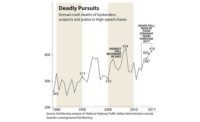Posted with permission from Fairwarning.org:
Sales of most corded window blinds and shades – products blamed for the strangulation deaths of more than 300 U.S. infants and toddlers since 1981 — will come to an end late this year.
The decision last week by the window covering industry to quit selling the items in the U.S. and Canada is a milestone following decades of stopgap safety measures and public clamor to do more to protect children. It means that, starting Dec. 15, retailers will stop offering most window coverings with pull strings and cords, unless the cords are placed in a way that keeps them out of the grasp of children and other consumers.
However, the industry decision to embrace what is the latest version of a voluntary safety standard falls short of complete victory for consumer advocates. It won’t apply to custom-order blinds and shades, which the industry says account for about 20 percent of the market, although these products will be subjected to some new safety requirements.
The custom-order exclusion was a disappointment for Linda Kaiser, president of Parents for Window Blind Safety, a grassroots group that she founded in 2002 after her daughter Cheyenne was killed in her crib. Kaiser also expressed concern about how strictly the ban on standard blinds and shades will be enforced. Still, she said she was hopeful that eliminating cords on standard window coverings will reduce future deaths and injuries.
| Want more stories like this from FairWarning? Sign up here to get news alerts. |
In addition, Kaiser views the decision as a reversal for an industry that safety advocates say has long exploited a loophole in the federal rule-making process to avoid making more substantial improvements. As Kaiser put it, “They finally said ‘uncle.’”
Window blind injuries were first identified in medical literature in 1945. In 1981, federal regulators cited window blind cords as a cause of strangulation deaths among children under five. A Consumer Product Safety Commission report at the time called the cords “a particularly insidious hazard.”
Deaths of at least 332 children
Since then, at least 332 children, most under the age of two, have been fatally strangled by window cords, according to federal data. Kaiser’s group has identified another 177 cases where children have suffered grievous injuries, including permanent brain damage or quadriplegia requiring lifelong care and therapy.
The mounting deaths and injuries have highlighted weaknesses in the ability of the CPSC to protect the public. Under the law, the agency is required to defer to industries that are developing manufacturing standards voluntarily rather than imposing mandatory federal rules; the theory is that industries have a strong incentive to keep their products safe.
|
More coverage: Years of Talking, Kids Still Dying Some Companies Break Ranks to Halt Risk of Kids Dying From Window CordsSafety Advocates Protest Stalled Talks Over Deadly Window Blind Hazard |
From 1994 to 2012, an industry trade group, the Window Covering Manufacturers Association, invoked the voluntary standards process a half-dozen times. It recommended design and other changes to window blinds and shades, but refused to banish cords, which consumer groups and CPSC staff saw as key to saving lives. In 2014, the CPSC began developing a mandatory government standard that would have required all window coverings to be cordless or have inaccessible cords. That work never was completed, however, and with the commission heading toward switching to a 3-2 Republican majority under the Trump administration, experts believe the initiative is dead.
Paul Nathanson, a spokesman for the manufacturers association, said new developments in cordless technology finally have made it possible for the industry to take its new voluntary safety action.
The longtime barrier was the presence of “thousands of types of window covering products. We could not wave a magic wand and make them all cordless,” Nathanson said. But now, he added, “Technology has got to the point where we can offer what consumers demand.”
‘Significant and immediate impact’
In a press release, Ralph Vasami, executive director of the manufacturers association, said the steps the industry has adopted “would have the most significant and immediate impact on reducing the strangulation risk to young children.”
Safety advocates, though, said there was no justification to ban cords on some products but not others. They predicted it would lead to consumer confusion, and more tragedy.
“We have known about this hazard for more than 70 years,” said Gary Smith, a pediatrician who heads the Center for Injury Research and Policy at the Nationwide Children’s Hospital in Columbus, Ohio. “The fact that the industry will not go the final step and simply eliminate all products that access cords just is beyond my comprehension.”
Smith co-authored a new study in the journal Pediatrics that counted 16,827 window blind-related injuries among children younger than age 6 who were treated in emergency departments from 1990 to 2015. Among those, 11.9 percent, or more than 2,000, involved entanglement injuries. While many injuries were minor, others required hospitalization or were fatal.
The manufacturers association said some corded blinds are “needed by a wide range of consumers, including the elderly and those with disabilities, those short in stature, and those with windows in hard to reach locations.” While industry officials noted that many custom blinds are available without cords, retailers said consumers are likely to buy ones with cords because they are much cheaper than equivalent cordless models.
“People are going to choose by price, and buy the product with the cord,” said Al Silverberg, CEO of SelectBlinds.Com, an online retailer that two years ago decided to quit selling corded blinds for safety reasons. Sales were so poor, he says, he was forced to reinstate corded options to stay afloat.
Jeremy Eastburn’s daughter, Presley, died in December 2016 after being strangled on a custom window blind the family bought for their new home near Houston. He said the seller provided assurance that the corded blinds were safe. Presley, 4, was watching cartoons in the media room, while Eastburn’s wife , Carolyn, was folding laundry in the bedroom down the hall.
“She had been separated from my wife for maybe 10 minutes,” Eastburn said. “My wife went into the room … and my daughter was hanging from the cord in the window.” Presley died at a hospital four days later.
Eastburn took little comfort in the industry’s new safety plan. He says it, like previous voluntary standards, has no teeth. With window blinds, he said, “up until now, the only consequences have been our dead children.”
Vasami, of the manufacturers association, said in the press release that companies will have to comply with the new voluntary standard “or face enforcement action by the CPSC” and other possible legal action.
But unlike a mandatory federal standard, the agency can only enforce a voluntary standard by going to court and showing that the non-compliance was unreasonable. Consumer groups doubt that the CPSC, once it switches to Republican control, would have much interest in doing that.
‘So much more work to do’
Elliot Kaye, a CPSC commissioner who chaired the agency during the Obama administration, said “it was extremely unfortunate and misleading” for the industry to claim in its news release that the new voluntary standard “was on par with a mandatory standard because it isn’t.”
“There’s no doubt this is a positive development. It would be disingenuous to say otherwise,” he added. “But there is so much more work to do.”
“They made a commitment to keep going and finish the job,” Kaye said, referring to a new task force the industry said it was creating to study further safety enhancements for custom products. “We expect them to live up to that commitment.” Kaye would also like the industry to offer incentives for consumers to swap out hazardous old blinds for safer cordless ones.
Kaiser said she is concerned that a flood of corded window blinds will be dumped on the market this year at deep discounts and bought by consumers unaware of, or not concerned about, the safety hazards.
Nathanson, the manufacturers association spokesman, said he doubts that will happen. “We have responsible members,” he said. “This has been in the works for a long time. I think manufacturers knew this was coming, and as always, they will respond in a responsible manner.”
About FairWarning
This story was reported by FairWarning (www.fairwarning.org), a nonprofit news organization based in Pasadena, Calif., that focuses on public health, safety and environmental issues.


